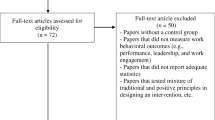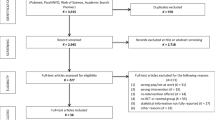Abstract
While research linking work organization factors to work-related musculoskeletal disorders has been increasing, there is still a need to delineate specific dimensions to be targeted by intervention programs. The present cross-sectional investigation identified work organization risk factors for low back (LB) and upper extremity (UE) symptoms and determined the magnitudes of such associations. Questionnaires containing items on ergonomic, individual psychosocial, and occupational psychosocial factors were administered to a sample of workers (n = 248 U.S. Marines) in previously identified high-risk job categories for musculoskeletal disorders. Study participants were categorized into groups of either having LB symptoms only, UE symptoms only, concurrent LB and UE symptoms, or being asymptomatic on the basis of self-report. Additionally, measures of pain intensity, physical function, and mental health were obtained. Linear regression analyses adjusting for demographics, ergonomic factors, and individual psychosocial factors indicated that decision authority and experienced responsibility for work were significant correlates for pain intensity during the week. Logistic regression analyses indicated that ergonomic stressors were a risk factor for all symptomatic groups (OR = 1.02 per point increase; 95% CI: 1.0–1.1). Time pressure (OR = 1.2 per point increase; 95% CI: 1.0–1.4) was also a significant risk factor for all symptomatic groups, while cognitive processing placed workers at higher risks for concurrent LB and UE symptoms (OR = 1.2; 95% CI: 1.0–1.4). Interpersonal demands placed individuals at a lower risk for LB symptoms (OR = 0.8; 95% CI: 0.5–1.0). Findings highlight the importance of intervention approaches that address time pressure, cognitive processing factors, and interpersonal demands at work. In light of past biobehavioral studies, these results also suggest that job redesign and interventions that address a worker's workstyle when faced with increased work demands may help reduce the likelihood of musculoskeletal symptoms and/or their intensity.
Similar content being viewed by others
REFERENCES
Straaton, KV, Fine, PR, White, MB, Maisiak, RS. Disability caused by work-related musculoskeletal disorders. Curr Opin Rheumatol 1998; 10: 141-145.
National Institute for Occupational Safety and Health. Musculoskeletal disorders and workplace factors: A critical review of epidemiologic evidence for work-related musculoskeletal disorders of the neck, upper extremity, and low back (NIOSH Publication No. 97-141). Cincinnati, OH: U.S. Department of Health and Human Services, 1997.
National Research Council. Musculoskeletal disorders and the workplace: Low back and upper extremities. Washington, DC: National Academy Press, 2001.
Huang, GD, Feuerstein, M, Sauter, SL. Occupational stress and work-related upper extremity disorders: Concepts and models. Am J Ind Med 2002; 41: 298-314.
Bongers, PM, Kremer, AM, ter Laak, J. Are psychosocial factors, risk factors for symptoms and signs of the shoulder, elbow or hand/wrist?: A review of the epidemiological literature. Am J Ind Med 2002; 41: 315-342.
Burdorf, A, Sorock, G. Positive and negative evidence of risk factors for back disorders. Scand J Work Environ Health 1997; 23: 243-256.
Sauter, SL, Hurrell, JJ, Fox, HR, Tetrick, LE, Barling, J. Occupational health psychology: An emerging discipline. Ind Health 1999; 37: 199-211.
National Institute for Occupational Safety and Health. National Occupational Research Agenda (NORA) (NIOSH Publication No. 96-115). Cincinnati, OH: U.S. Department of Health and Human Services, 1996.
Cooper, CL, Marshall, J. Occupational sources of stress: A review of the literature relating to coronary heart disease and mental ill health. J Occup Psychol 1976; 49: 11-28.
Hagberg, M, Silverstein, B, Wells, R, Smith, MJ, Hendrick, HW, Carayon, P, Perusse, M. Work related musculoskeletal disorders (WMSDS): A reference book for prevention. London: Taylor & Francis, 1995.
Ohlsson, K, Attewell, R, Paisson, B, Karlsson, B, Balogh, I, Johnsson, B, Ahlm, A, Skerfving, S. Repetitive industrial work and neck and upper limb disorders in females. Am J Ind Med 1995; 27: 731-747.
Punnett, L, Fine, LJ, Keyserling, WM, Herrin, GD, Chaffin, DB. Back disorders and nonneutral trunk postures of automobile assembly workers. Scand J Work Environ Health 1991; 17: 337-346.
Hurrell, JJ, Murphy, LR. Occupational stress intervention. Am J Ind Med 1996; 29: 338-341.
Kirstensen, TS. Workplace intervention studies. Occup Med: State Art Rev 2000; 15: 293-305.
van der Hek, H, Plomp, HN. Occupational stress management programmes: A practical overview of published effect studies. Occup Med1997; 47:133-141.
Huang, GD, Feuerstein, M, Arroyo, F. Back and upper extremity disorders in enlisted U.S. Marine Corps personnel: Burden and individual risk factors. Mil Med 2001; 166: 1007-1017.
Huang, GD, Feuerstein, M, Kop, W, Schor, K, Arroyo, F. Individual and combined impacts of biomechanical and work organization factors in work-related musculoskeletal symptoms. Am J Ind Med 2003; 43: 495-506.
U.S. Department of Defense. Occupational Conversion Index: Enlisted/officer/civilian. Washington, DC: U.S. Department of Defense, 1997.
Marcotte, A, Barker, R, Joyce, M, Miller, N, Klinenberg, EJ, Cogburn, CD, Goddard, DE. Preventing work-related musculoskeletal illnesses through ergonomics: The Air Force PREMIER Program. Vol. 2: Job Requirements and Physical Demands Survey methodology guide (field version). Brooks Air Force Base, TX: Occupational and Environmental Health Directorate, 1997.
Dane, D, Feuerstein, M, Huang, GD, Dimberg, L, Ali, D, Lincoln, A. Measurement properties of a self-report index of ergonomic exposures for use in an office work environment. J Occup Environ Med 2002; 44: 73-81.
Huang, GD, Feuerstein, M, Berkowitz, SM, Peck, CA. Occupational upper-extremity-related disability: Demographic, physical, and psychosocial factors. Mil Med 1998; 163: 552-558.
Feuerstein, M, Berkowitz, S, Huang, GD. Predictors of occupational low back disability: Implications for secondary prevention. J Occup Environ Med 1999; 41: 1024-1031.
Moos, RH. Work Environment Scale manual (3rd edn.). Palo Alto, CA: Consulting Psychologists Press, 1994.
Hales, TR, Sauter, SL, Peterson, MR, Fine, LJ, Putz-Anderson, V, Schleifer, LR, Ochs, TT, Bernard, BP. Musculoskeletal disorders among visual display terminal users in a telecommunications company. Ergonomics 1994; 37: 1603-1621.
Karasek, R, Brisson, C, Kawakami, N, Houtman, I, Bongers, P, Amick, B. The Job Content Questionnaire (JCQ): An instrument for internationally comparative assessments of psychosocial job characteristics. J Occup Health Psychol 1998; 3: 322-355.
Hackman, JR, Oldham, GR. The Job Diagnostic Survey: An instrument for the diagnosis of jobs and the evaluation of job redesign projects (Tech. Rep. No. 4). New Haven, CT: Yale University, 1974.
Caplan, RD. Organizational stress and individual strain: A social psychological study of risk factors in coronary heart disease among administrators, engineers, and scientists. Ann Arbor, MI: Institute for Social Research, 1971.
Feuerstein, M, Sult, S, Houle, M. Environmental stressors and chronic low back pain: Life events, family and work environment. Pain 1985; 22: 295-307.
Moos, RH, Moos, BS. Family Environmental Scale manual. Palo Alto, CA: Consulting Psychologists Press, 1981.
Bernard, B, Sauter, S, Fine, L, Petersen, M, Hales, T. Job task and psychosocial risk factors for work-related musculoskeletal disorders among newspaper employees. Scand J Work Environ Health 1994; 20: 417-426.
Huskisson, E. Measurement of pain. Lancet 1974; 9: 1127-1131.
Ware, J, Kosinski, M, Keller, SD. A 12-item Short-Form Health Survey: Construction of scales and preliminary tests of reliability and validity. Med Care 1996; 34: 220-233.
Ware, JE, Sherbourne, CD. The MOST 36-item Short-Form Health Survey (SF-36). Med Care 1992; 30: 473-483.
Feuerstein, M, Huang, GD, Haufler, AJ, Miller, JK. Development of a screen for predicting clinical outcomes in patients with work-related upper extremity disorders. J Occup Environ Med 2000; 42: 749-761.
Bessette, L, Sangha, O, Kuntz, KM, Keller, RB, Lew, RA, Fossel, AH, Katz, JN. Comparative responsiveness of generic versus disease specific weighted versus unweighted health status measures in carpal tunnel syndrome. Med Care 1998; 36: 491-502.
Hosmer, DW, Lemeshow, S. Applied logistic regression. New York: Wiley, 2000.
Keppel, G, Saufley, WH, Tokunaga, H. Introduction to design and analysis (2nd edn.). New York: Freeman, 1992.
Feuerstein, M, Armstrong, T, Hickey, P, Lincoln, A. Computer keyboard force and UE symptoms. J Occup Environ Med 1997; 39: 1144-1153.
Birch, L, Juul-Kristensen, B, Jensen, C, Finsen, L, Christensen, H. Acute response to precision, time pressure and mental demand during simulated computer work. Scand J Work Environ Health 2000; 26: 299-305.
Engstrom, T, Hanse, JJ, Kadefors, R. Musculoskeletal symptoms due to technical preconditions in long cycle time work in an automobile assembly plant: A study of prevalence and relation to psychosocial factors and physical exposure. Appl Ergon 1999; 30; 443-453.
Krause, N, Ragland, DR, Fisher, JM, Syme, SL. Psychosocial job factors, physical workload, and incidence of work-related spinal injury: A 5-year prospective study of urban transit operators. Spine 1998; 23: 2507-2516.
Lundberg, U, Dohns, IE, Melin, B, Sandsjo, L, Palmerud, G, Kadefors, R, Ekstrom, M, Parr, D. Psychophysiological stress responses, muscle tension, and neck and shoulder pain among supermarket cashiers. J Occup Health Psychol 1999; 4: 245-255.
Waersted, M, Eken, T, Westgaard, RH. Activity of single motor units in attention-demands tasks: Firing pattern in the human trapezius muscle. Eur J Appl Physiol Occup Physiol 1996; 72: 323-329.
Waersted, M, Westgaard, RH. Attention-related muscle activity in different body regions during VDU work with minimal physical activity. Ergonomics 1996; 39: 661-676.
Dehlin, O, Berg, S. Back symptoms and psychological perception of work. Scand J Rehabil Med 1977; 9: 61-65.
Leino, PI, Hanninen, V. Psychosocial factors at work in relation to back and limb disorders. Scand J Work Environ Health 1995; 21: 134-142.
Ylipaa, V, Arnetz, BB, Preber, H. Predictors of good general health, well-being, and musculoskeletal disorders in Swedish dental hygienists. Acta Odontol Scand 1999; 57: 277-282.
Bendix, T. Low back pain and seating. In: Lueder, R, Noro, K, eds. Hard facts about soft machines: The ergonomics of seating. Bristol, PA: Taylor & Francis, 1994, pp. 147-155.
Wright, A, Sluka, KA. Nonpharmacological treatments for musculoskeletal pain. Clin J Pain 2001; 17: 33-46.
Moore, TM. A workplace stretching program. Physiologic and perception measurements before and after participation. AAOHN J 1998; 46: 563-568.
Tanaka, S, Wild, DK, Seligman, PJ, Cameron, LL, Freund, E. Association of occupational and non-occupational risk factors with the prevalence of self-reported carpal tunnel syndrome in a national survey of the working population. Am J Ind Med 1997; 32: 550-556.
Pransky, G, Himmelstein, J. Outcomes research: Implications for occupational health. Am J Ind Med 1996; 29: 573-583.
Wiktorin, C, Karlqvist, L, Winkel, J. Validity of self-reported exposures to work postures and manual materials handling. Scand J Work Environ Health 1993; 19: 208-214.
Scheer, SJ, Mital, A. Ergonomics. Arch Phys Med Rehabil 1997; 78(Suppl 3): S36-S45.
Chaffin, D. Biomechanical aspects of workplace design. In: Salvendy, G, ed. Handbook of human factors and ergonomics (2nd edn.). New York: Wiley, 1997, pp. 772-789.
Smith, MJ, Cohen, WJ. Design of computer terminal workstations. In: Salvendy, G, ed. Handbook of human factors and ergonomics (2nd edn.). New York: Wiley, 1997, pp. 1637-1688.
D'Zurilla, TJ, Chang, EC. The relation between social problem solving and coping. Cogn Res Ther 1995; 19: 547-562.
D'Zurilla, TJ, Sheedy, CF. Relation between social problem-solving ability and subsequent level of psychological stress in college students. J Pers Soc Psychol 1991; 61: 841-846.
Xerox Corporation. Leadership through quality: Problem-solving process. User's manual. Rochester, NY: Multinational Customer and Service Education, 1986.
Feuerstein, M, Huang, GD, Pransky, G. Workstyle and work-related upper extremity disorders. In: Gatchel, RJ, Turk, DC, eds. Psychosocial factors in pain. New York: Guilford Press, 1999, pp. 175-192.
Kasl, SV. Measuring job stressors and studying the health impact of the work environment: An epidemiologic commentary. J Occup Health Psychol 1998; 3: 390-401.
Spector, PE, Jex, SM. Development of four self-report measures of job stressors and strain: Interpersonal Conflict at Work Scale, Organizational Constraints Scale, Quantitative Workload Inventory, and Physical Symptoms Inventory. J Occup Health Psychol 1998; 3: 356-367.
Vagg, PR, Spielberger, CD. Occupational stress: Measuring job pressure and organizational support in the workplace. J Occup Health Psychol 1998; 3: 294-305.
National Institute for Occupational Safety and Health. The changing organization of work and the safety and health of working people (NIOSH Publication No. 2002-116). Cincinnati, OH: U.S. Department of Health and Human Services, 2002.
Author information
Authors and Affiliations
Corresponding author
Rights and permissions
About this article
Cite this article
Huang, G.D., Feuerstein, M. Identifying Work Organization Targets for a Work-Related Musculoskeletal Symptom Prevention Program. J Occup Rehabil 14, 13–30 (2004). https://doi.org/10.1023/B:JOOR.0000015008.25177.8b
Issue Date:
DOI: https://doi.org/10.1023/B:JOOR.0000015008.25177.8b




